The Radeon R9 280X Review: Feat. Asus & XFX - Meet The Radeon 200 Series
by Ryan Smith on October 8, 2013 12:01 AM ESTAsus Radeon R9 280X DirectCU II TOP
Our other sample card sent over by AMD for today’s launch is a sample of what a factory overclocked cards will look like. For this AMD sent over Asus’s Radeon R9 280X DirectCU II TOP, Asus’s traditional high-end custom cooled factory overclocked card.
Asus ships their TOP card card at 970MHz for the base GPU clock, 1070MHz for the GPU boost clock, and 6400MHz for the memory, which compared to the R9 280X reference clocks is a very significant overclock of 120MHz (14%) for the core clock, 70MHz (7%) for the boost clock, and 400MHz (7%) for the memory overclock. The narrowing of the gap between the core clock and the boost clock is particularly interesting, as it means the Asus card operates in a smaller range of clockspeeds than reference cards do (100MHz versus 150MHz). The core overclock in particular virtually guarantees that the card will be operating at higher clockspeeds than most reference clocked 280Xs when they’re boosting, never mind when the Asus card is also boosting. The fact that PowerTune Boost on the 280X is equivalent in operation to how it was on the 7970GE – which is to say opaque – means that it’s difficult to predict exactly how this overclock will affect its performance, so for that we’ll have to turn to our performance numbers later.
Diving into the design of the 280X DCUII TOP, while Asus’s design is fundamentally yet another dual fan open air cooler, upon further examination it’s clear that for their design Asus has gone with something that can safely be described as exotic and unusual. This is almost immediately apparent in looking at their DirectCU II cooler, or more specifically the fans on it. While the right fan is a standard 95mm axial fan, the left fan is a 100mm fan that is easily the oddest fan we’ve seen in quite some time.
Asus calls it “CoolTech” and it’s essentially an effort to build a fan that’s both an axial fan and a blower (radial) fan at the same time, explaining the radial-like center and axial-like outer edge of the fan. Asus tells us that they’re shooting for a fan that can move air over a wider angle than a traditional axial fan, and while we’re hardly qualified to evaluate that claim, it is regardless certainly something we’ve never seen before.
Asus’s choice in fans aside, for their 280X card Asus has also gone with a fairly large single segment heatsink to provide heat dissipation for their GPU. The DirectCU II heatsink itself measures 10.5 inches and brings the total length of the card out to about 11.5 inches. Embedded in the heatsink are 5 heatpipes that run between the GPU core and various points on the heatsink, the largest heatpipe measuring 10mm in diameter. Meanwhile a smaller separate heatsink is mounted to the MOSFETs on the board to provide cooling for those, with the Hynix 6GHz GDDR5 RAM chips running bare. Asus tells us this design is 20% cooler and much quieter than the reference design for 280X, but since that design isn’t in retail it’s something of a moot point as Asus’s competition will be other custom designs.
Moving on, like most of Asus’s customized high-end cards the company has outfit the 280X DCUII TOP with their DIGI+ digital VRM management IC and Super Alloy Power discrete components. As to be expected, Asus is promoting these component choices as improving overclocking stability while further improving the lifespan of the components themselves. Perhaps more importantly, Asus has gone with a 10 phase power implementation on their card to give the card more overclocking headroom on the power side, outfitting the card with 8 power phases for the GPU as opposed to the typical 5 phases, and the same 2 phase memory/IO setup. As we’ll see in our look at performance and power consumption Asus already seems to be running this card at over 250W, so even before end-user overclocking they’re already making use of their own overclocking headroom to provide the factory overclock and the power needed to operate it.
Speaking of overclocking, the 280X DCUII TOP comes with Asus’s GPU Tweak overclocking software for further end-user overclocking. This is the first time we’ve seen their GPU Tweak software in a video card review, and it’s clear right off the bat that they’ve been watching MSI closely and have implemented something very similar to MSI’s Afterburner software.
The end result is a very competent overclocking suite that offers all of the overclocking and monitoring functionality we’ve come to expect from a good overclocking utility, including a wide array of monitoring options and support for GPU voltage control. Asus’s taste in skins is unfortunate – a low contrast red on black – but otherwise the UI itself is similarly solid. To that end GPU Tweak won’t match Afterburner on some of its more fringe features such as recording and overlays, but as a pure overclocking utility it stands up rather nicely.
On a side note, Asus also throws in a live streaming utility called GPU Tweak Streaming, apparently aimed at the DOTA/League of Legends/Let’s Play crowd. Having no real experience with such utilities I can hardly comment on it, but at a superficial level it seems to do what it’s supposed to.
Moving on, let’s briefly talk about I/IO options. In a slight deviation from what we normally see for a Radeon card, Asus has dropped the two Mini DisplayPorts for a single full-size DisplayPort. Given the seemingly random nature by which various board partners go about choosing which port to use we can hardly speculate on why this is, but all things considered I’m not sure why Asus would want fewer connectivity options. This leaves Asus with 2x DL-DVI, 1x HDMI, and 1x DisplayPort 1.2 for connectivity, for a total of 4 ports.
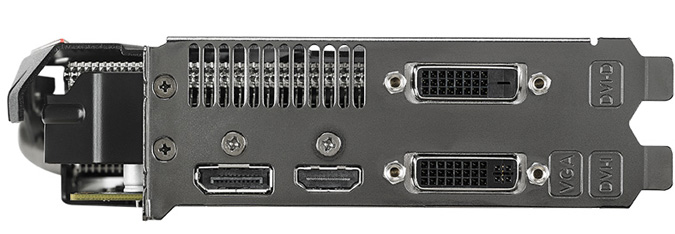
Winding things down, I also wanted to quickly call attention to a couple of specific design decisions Asus made with their card. The first is a rather useful change Asus made with their PCIe power connectors. Asus has reversed the power connectors so that they’re facing the rear of the card rather than the front, and consequently the clips on the plugs don’t dig into the heatsink. This is the first time we’ve seen anyone reverse the connectors like this, and it’s a handy change that makes unplugging the card much easier. And as a side benefit, they’ve also put LEDs on the card that indicate whether there is a working PCIe power connection, just in case you’re the forgetful type who doesn’t always remember to plug in those connectors (like myself).
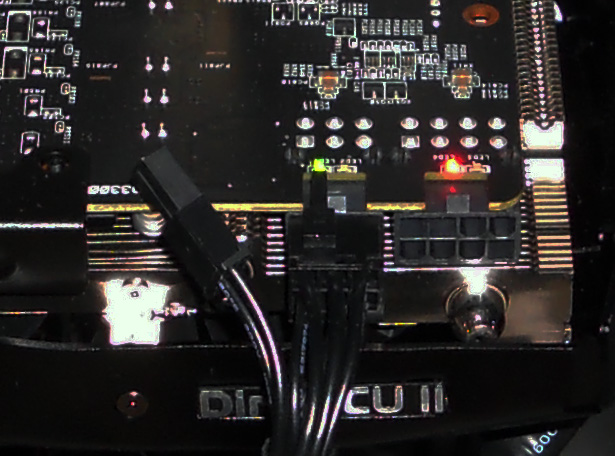
Reversed PCIe power sockets; LED power indicators
At the same time however the odd shape of the shroud over the card deserves a brief mention for an opposite reason. Getting the PCIe plugs in and out will be easy, but with the shroud sticking up almost an inch and a half towards the front of the card, screwing and unscrewing the card’s bracket requires nimble fingers or a good magnetized screwdriver, making it more difficult (though by no means impossible) than it really should be.
Finally, let’s quickly talk warranties and pricing. Asus is offering their standard 3 year warranty with this card, which although is not quite as long as XFX’s warranty is at least typical for this industry. Meanwhile on pricing Asus has very much gone for the kill, pricing the card at just $10 over MSRP, or $309. As we’ll see the factory overclock alone is good for a several percent improvement in performance over a stock 280X, never mind Asus’s cooling performance and value added features such as their software. Although this is hardly a representative sample of all 280X cards on the market, in this light the 280X DCUII TOP is looking especially good.



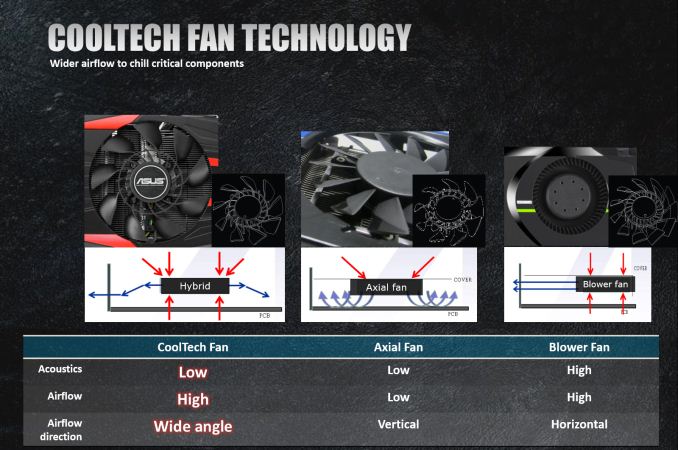
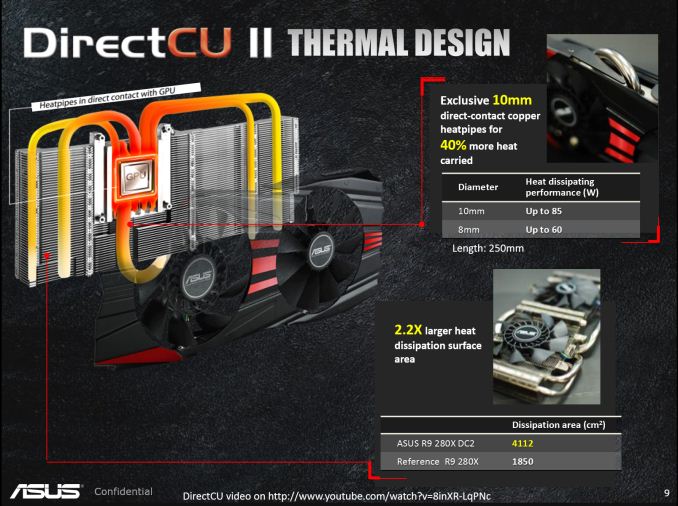
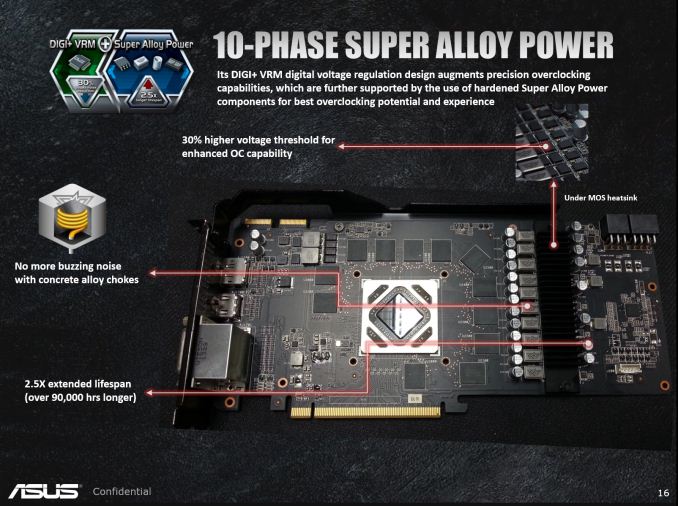









151 Comments
View All Comments
varad - Tuesday, October 8, 2013 - link
Last 2 sections are missingA5 - Tuesday, October 8, 2013 - link
As is the [Product Specs] Table on Page 1.varad - Tuesday, October 8, 2013 - link
Looks like there are many more diagrams and charts missingyacoub35 - Tuesday, October 8, 2013 - link
Yep. Article was probably set to auto-post but the associated images (and apparently the last two pages) are missing.Anyway, the gist of this seems to be that the 280X is the price and performance the 7970 should have been two years ago. But since they went with crazy-high pricing on the 7900 series, they can now release this product at the price point that would have been appropriate two years ago and still make out like bandits with reworked 7900 hardware which must be exceptionally cheap for them to produce at this age of maturity on the fabs. Good for their revenue, but probably not going to entice NVidia to drop their prices much.
If this is what we're getting as top-of-the-line in the normal-people price bracket from AMD, it makes me happy I picked up a 7970 on a great sale recently.
Now we can watch the 290X, which should be $399, $100 more or less than the 280X in keeping with the normal pricing separation between models, come in around $549 instead. What a joke.
Spoelie - Tuesday, October 8, 2013 - link
How is that different from EVERY OTHER COMPANY out there? What about NVIDIA to introduce Titan at a 1000 when their next highest card was at 500?Prices are dictated by competitive landscape and demand/price curves, maximizing profit - not by what you want it to cost, or some mathematical ideal of "perfect 100$ separation". Don't like it, don't buy it.
Galidou - Tuesday, October 8, 2013 - link
+1 for Spoelieblanarahul - Tuesday, October 8, 2013 - link
Am I the only when who is happy that we finally get a long awaited price cut? The stores in my country don't drop prices like the Americans' do. So for me, it's a great time to upgrade. GPU power has never been so cheap!blanarahul - Tuesday, October 8, 2013 - link
Correction: "Am I the only 'one' who is happy....."Sigh. Brain fart.
HisDivineOrder - Wednesday, October 9, 2013 - link
I don't think I saw him comment on how much he was glad nVidia wasn't like AMD. I'm pretty sure he was just commenting on how AMD was doing something he didn't like.No need to kneejerk defend AMD, friend. Just allow him to be annoyed with AMD for doing something that is annoying. When nVidia does it, he can be annoyed with them, too. Nothing in his post screams, "nVidia's okay when they do it!"
Galidou - Saturday, October 12, 2013 - link
yacoub35's comment was plain stupid and lacked of analysis he says: ''280X is the price and performance the 7970 should have been two years ago. But since they went with crazy-high pricing on the 7900 series''. Nope, 7970 price was higher at launch like every other card for a reason, it was the new stuff. Like many generation, a new card replaces the old king at or a little Under it's price to let the old king on the shelves sell for a reasonable amount. Difference from before is that the price cut happens during the life of the video card because they live longer on the shelves. So when the new stuff comes out, the old stuff is priced already correctly so no one feels SOO bad for buying a video card a month before new ones come out and lower the prices by a LARGE amount.